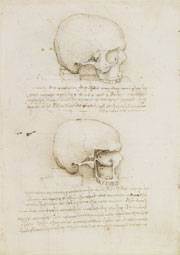
Gilles Barbier – L’Hospice / The Nursing Home 2002
six wax figures, television, various elements dimension variable
Martin Z. Margulies, Miami, USA
Courtesy: Galerie G.-P. & N. Vallois, Paris, France

Leonardo da Vinci
Two Studies of a Cranium
1489
pen and ink, over traces of black chalk
18.8×13.4 cm
ROYAL COLLECTION
©2009 HER MAJESTY QUEEN
ELIZABETH II

E. Muller – Set of 50 Artificial Glass Eyes
1900-1940 / Liverpool, England
glass, wood, velvet, leatherette
3x31x18 cm
Science Museum, London

Jacques-Fabien Gautier d’Agoty
Dissection of a Pregnant Female Figure, Lateral View
1764-65
oil on canvas
193×53.5 cm
Wellcome Library
Medicine and Art at the Mori Art Museum
Since time immemorial, people have sought to understand themechanisms of the human body. On the basis of their discoveriesin medicine and science, people have attempted to counter theeffects of disease and injury and to resist death, seeking ultimatelythe secret of longevity.
28 november (Sat), 2009 – 28 February (sun), 2010
]]>
Source: Mori Art Museum
The history of medicine is the sum of allsuch scientific explorations into the nature of the human body.Likewise, attempts to create depictions of beauty have also beenrepeated in history. The human body, in fact, has always been heldup as a place to embody the ideal form of beauty, and peoplehave never tired of its depiction.
In this way, the body can be seen as the meeting point, or thepoint of departure for journeys into the two very different worldsof medicine and art. The scientist/artist who obviously stoodmost prominently at this intersection was Leonardo da Vinci. Heleft us not only stunningly accurate anatomical drawings, but alsothe Mona Lisa. Developments in science and technology have been essential to the advancement of medicine in the past, andthese days too, medicine is advancing with developments in molecular biology. We are now able to explain the mechanism ofDNA and shed new light on the question of what a living organism is.
This exhibition brings together roughly 150 important medical artifacts from the Wellcome Collection (http://www.wellcomecollection.org) in London, historical art works as well as about 30 works of contemporary art. It is a unique attempt to reconsider the fundamentalquestion of the meaning of life and death from the parallel, yet rarely compared perspectives of medicine and art, or science and beauty.Also, three anatomical drawings by Leonardo da Vinci from The Royal Collection will be on display for the first time in Japan.
Exhibition sections and exhibited artists
Part 1 – Discovering the Inner World of the Body
How did people around the world first acquire understanding of the mechanisms of the human body and the vast world itcontains? The first section of the exhibition answers that question by tracing various scientific developments through a vastarray of artifacts. Exhibited works include anatomical drawings by Leonardo da Vinci and Michelangelo, anatomical diagramsand models from around the world. There are also works of contemporary art by Andy Warhol, Magnas Wallin, and Bai Yilao,aswell as traditional Japanese works of art by the likes of Maruyama Ōkyo and Kawanabe Kyosai.
Part 2 – Fighting Against Death and Disease
This section looks at how people perceive death and disease and how they have tried to fight against it. In addition topresenting the history of medicine, pharmaceuticals, life sciences and scientific technology, this section poses philosophicalquestions about the nature of life and death. Exhibited works include Japanese anatomical texts as well as medical journalsand historical medical instruments from around the world. There are also paintings on the theme of medicine and works ofcontemporary art made by Damien Hirst, Marc Quinn and Yanagi Miwa.
Part 3 – Toward Eternal Life and Love
In light of the latest developments in biotechnology, cybernetics and neuroscience, and with reference to medical materialsand works of art, the third part of the exhibition poses the following questions: Considering reproduction is simply theendless repetition of the life-death cycle, what really motivates humans to reproduce? Is it possible to pinpoint the realobjective of human life and its likely future? What is life?Exhibited works include drawings by René Descartes, illustrations by Francis Crick of the double-helix structure of DNA, andcontemporary artworks by Francis Bacon, Jan Fabre, Matsui Fuyuko and others.
Follow us on:


